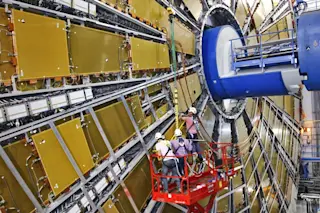On the outskirts of Geneva, Switzerland, some 300 feet underground, is the biggest, most complicated machine ever built. With about 1,200 giant superconducting magnets, multiple-ton detectors, a worldwide computing grid and a staff of thousands, the Large Hadron Collider is an international undertaking beyond the means of any single nation. The project’s mission: to see what happens when protons collide at 99.99999 percent of the speed of light in a 17-mile-long circular tunnel.
The LHC started operating in 2008, yet for some physicists it only recently began to live up to its name. “I called it the Little Hadron Collider,” says Maria Spiropulu, an experimental physicist at the California Institute of Technology, “because during its first run, it only operated at half-energy.” That changed in April when the accelerator fired up again after a two-year shutdown dedicated to nearly doubling the energy of its proton beams. Now physicists are anticipating ...














